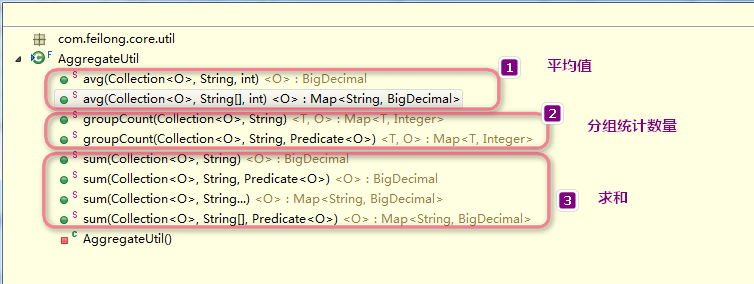-
Notifications
You must be signed in to change notification settings - Fork 155
统计专家 AggregateUtil
JAVA开发统计少不了的,我们来看看 统计专家 - AggregateUtil
主要由下面几个部分组成:
| 方法 | Description |
|---|---|
| avg(Collection, String, int) | 算术平均值 |
| avg(Collection, String[], int) | 算术平均值 |
算术平均值.
示例: 场景: 求的User list 里面 id属性 的平均值
List<User> list = new ArrayList<>();
list.add(new User(2L));
list.add(new User(5L));
list.add(new User(5L));
AggregateUtil.avg(list, "id", 2)**返回:**4.00
算术平均值.
说明:
- 返回的
LinkedHashMap,key是propertyNames的元素,value是基于这个属性名称获得的值的平均值;key的顺序是依照 propertyNames元素的顺序
示例: 场景: 求的User list 里面 age 以及id属性 的平均值
User user1 = new User(2L);
user1.setAge(18);
User user2 = new User(3L);
user2.setAge(30);
List<User> list = toList(user1, user2);
Map<String, BigDecimal> map = AggregateUtil.avg(list, ConvertUtil.toArray("id", "age"), 2);
LOGGER.info(JsonUtil.format(map));返回:
{
"id": 2.5,
"age": 24
}| 方法 | Description |
|---|---|
| groupCount(Collection, String) | 循环 objectCollection,统计 propertyName 的值出现的次数. |
| groupCount(Collection, String, Predicate) | 循环 objectCollection,只选择符合 includePredicate的对象,统计 propertyName的值出现的次数. |
循环 objectCollection,统计 propertyName 的值出现的次数.
说明:
- 返回的
LinkedHashMap,key是propertyName对应的值,value是该值出现的次数; - 顺序是
objectCollection propertyName的值的顺序
示例: 场景: 统计user list,属性名字是name 的值的数量
List<User> list = new ArrayList<>();
list.add(new User("张飞"));
list.add(new User("关羽"));
list.add(new User("刘备"));
list.add(new User("刘备"));
Map<String, Integer> map = AggregateUtil.groupCount(list, "name");
LOGGER.info(JsonUtil.format(map));返回:
{
"张飞": 1,
"关羽": 1,
"刘备": 2
}循环 objectCollection,只选择符合 includePredicate的对象,统计 propertyName的值出现的次数.
说明:
- 返回的
LinkedHashMap,key是propertyName对应的值,value是该值出现的次数; - 顺序是 objectCollection propertyName的值的顺序
示例:
场景: 统计user list(条件是 age > 30 的user),name属性值的数量
List<User> list = new ArrayList<>();
list.add(new User("张飞", 20));
list.add(new User("关羽", 30));
list.add(new User("刘备", 40));
list.add(new User("赵云", 50));
Map<String, Integer> map = AggregateUtil.groupCount(list, "name", new Predicate<User>(){
@Override
public boolean evaluate(User user){
return user.getAge() > 30;
}
});
LOGGER.debug(JsonUtil.format(map));返回:
{
"刘备": 1,
"赵云": 1
}| 方法 | Description |
|---|---|
| sum(Collection, String) | 总和,计算集合对象objectCollection 内指定的属性名 propertyName 值的总和. |
| sum(Collection, String, Predicate) | 迭代objectCollection,提取 符合 includePredicate的元素的指定 propertyName 元素的值 ,累计总和. |
| sum(Collection, String...) | 总和,计算集合对象objectCollection 内指定的属性名 propertyNames 值的总和. |
| sum(Collection, String[], Predicate) | 迭代objectCollection,提取符合 includePredicate的元素的指定 propertyNames 元素的值 ,累计总和. |
总和,计算集合对象objectCollection 内指定的属性名 propertyName 值的总和.
说明:
- 如果通过反射某个元素值是null,则使用默认值0代替,再进行累加
示例:
List<User> list = new ArrayList<>();
list.add(new User(2L));
list.add(new User(5L));
list.add(new User(5L));
LOGGER.info("" + AggregateUtil.sum(list, "id"));**返回:**12
说明: 当你需要写这样的代码的时候,
protected Integer getCookieShoppingCartLinesQty(List<CookieShoppingCartLine> cartLineList){
Integer qty = 0;
//获取cookie中的购物车行集合
if (null != cartLineList && cartLineList.size() > 0){
for (Iterator iterator = cartLineList.iterator(); iterator.hasNext();){
CookieShoppingCartLine cookieShoppingCartLine = (CookieShoppingCartLine) iterator.next();
qty += cookieShoppingCartLine.getQuantity();
}
}
return qty;
}你可以写成:
protected Integer getCookieShoppingCartLinesQty(List<CookieShoppingCartLine> cartLineList){
return isNullOrEmpty(cartLineList) ? 0 : AggregateUtil.sum(cartLineList, "quantity").intValue();
}迭代objectCollection,提取符合 includePredicate的元素的指定 propertyName 元素的值 ,累计总和.
说明:
- 如果通过反射某个元素值是null,则使用默认值0代替,再进行累加
示例:
场景: 统计user list(条件是 id >10),id属性值的总和
List<User> list = new ArrayList<>();
list.add(new User(2L));
list.add(new User(50L));
list.add(new User(50L));
AggregateUtil.sum(list, "id", new Predicate<User>(){
@Override
public boolean evaluate(User user){
return user.getId() > 10L;
}
});返回:new BigDecimal(100L)
当然这段代码,你还可以优化成:
Predicate<Long> predicate = new ComparatorPredicate<Long>(10L, ComparatorUtils.<Long> naturalComparator(), Criterion.LESS);
BigDecimal sum = AggregateUtil.sum(list, "id", new BeanPredicate<User>("id", predicate));总和,计算集合对象objectCollection 内指定的属性名 propertyNames 值的总和.
说明:
- 如果通过反射某个元素值是null,则使用默认值0代替,再进行累加
示例: 场景: 在user list 中,分别统计 id属性以及age属性值总和
User user1 = new User(2L);
user1.setAge(18);
User user2 = new User(3L);
user2.setAge(30);
Map<String, BigDecimal> map = AggregateUtil.sum(toList(user1, user2), "id", "age");
LOGGER.info(JsonUtil.format(map));返回:
{
"id": 5,
"age": 48
}迭代objectCollection,提取符合 includePredicate的元素的指定 propertyNames 元素的值 ,累计总和.
示例:
User user1 = new User(10L);
user1.setName("刘备");
user1.setAge(50);
User user2 = new User(20L);
user1.setName("关羽");
user2.setAge(50);
User user3 = new User(100L);
user3.setName("张飞");
user3.setAge(100);
List<User> list = toList(user1, user2, user3);
Map<String, BigDecimal> map = AggregateUtil.sum(list, ConvertUtil.toArray("id", "age"), new Predicate<User>(){
@Override
public boolean evaluate(User user){
return !"张飞".equals(user.getName());
}
});
LOGGER.debug(JsonUtil.format(map));返回:
{
"id": 30,
"age": 100
}